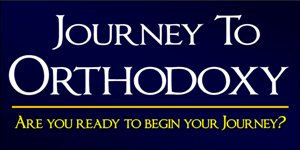Who is Orthodoxy for?
Orthodoxy is for those who are searching for the meaningful experience of worship. In Orthodoxy, we practice Christianity in the truest way, with the real presence of Christ, from our Holy Communion to reciting the very same prayers as the first Christians. We believe that in order to really be with God, you have to be to be “immersed in the experience” or to be transformed by the Sacraments–most notably the Eucharist.
Do I have to be Greek to belong to the Orthodox Faith?
No! The Orthodox Church is open to everyone and welcomes every culture, ethnicity, and faith background for worship and to consider membership. The Orthodox Church is even experiencing growth in the United States, as many Americans not raised as Orthodox Christians are finding peace, truth and meaning in Orthodox worship and doctrine.
What is the proper name for the Orthodox Church?
Sometimes the Orthodox Christian Church is also called the Eastern Orthodox Church. Names like Greek Orthodox, Russian Orthodox, Syrian Orthodox, Ukrainian Orthodox, Albanian Orthodox, Serbian Orthodox, and Romanian Orthodox are all names for the same Church under the same faith. Within these churches, there may be cultural and language differences, but the liturgy remains the same.
What can I expect at a service?
If you have never entered an Orthodox Church before or experienced an Orthodox worship service, you might find it strange when you first visit. You will, however, be moved by the transformative power of the Divine Liturgy. That is because you are traveling back in time, and experiencing worship akin to when the Church was young. Orthodox Christianity is about transforming you to be holy, to be one with God. Early Christian worship was a very sensory experience. Orthodox Christianity maintains these aspects of worship that engage all of your senses – from the incense, to the hymns, chants and bells, to the sprinkling of Holy Water. In the United States, Sunday services (known as Divine Liturgy) usually last between an hour to an hour and a half.
Are the services in English?
Yes, services are almost entirely in English here. There are also many Orthodox Christian Churches who still use the language of their ancestors such as Greek, Russian, Serbian, Arabic. You do not have to identify with any ethnic or cultural background or know another language in order to attend services or join the Orthodox Christian Church.
Is Orthodox Christianity more for older people?
Orthodox Christianity is old, but it’s far from out of touch. In fact, its “oldness” is exactly what makes it the most “in touch” form of worship in the Christian faith. It is going back to when the Church was young. Orthodoxy isn’t about innovation; it’s about perpetuation. Christ’s words don’t change with the time, and we believe the traditions of the earliest church shouldn’t either. Orthodox Christian churches have active members of all ages, including from teens and college students to new parents and young professionals, who are passionate about their faith and eager to welcome new friends and members.
Why is the service the same every week?
In our world full of restlessness and busyness, many people find that the unchanging Liturgy brings a sense of peace and calm. They also find that different parts of the Liturgy speak to them, depending on what they are experiencing in their lives that day. It allows us to see the timeless word of God from different perspectives. The petitions offered are timeless and the chanting moves one to a higher level of spirituality. Orthodox worship is God centered, not self-centered. Orthodox Christians believe that we participate in heavenly worship in a mystical manner, and that being in church helps us to reconnect with God. For Orthodoxy, the Church is the center of the universe, and the Eucharist the central sacrament of the Church. Thus, liturgy encompasses the heart of Orthodoxy. It is not just calming; it is transformational—the reincarnation of Eden.
Why does the Orthodox Church use icons?
There is historical evidence that the ancient church used icons. Many people of the early church were illiterate, and icons were a way to teach about Christ. There is a difference between worshiping an icon and venerating/honoring an icon. In Orthodoxy, one may not worship an icon — that would be a grave sin. But we can venerate the persons to whom the icons point – Jesus, Mary and the saints. Icons are meant to elicit an emotional response from us, to raise both our minds and our hearts to a divine level. They are windows into the heavenly presence of those before us who lived a life in Christ. “In a very real sense, every church is filled with icons — because every church is filled with people who bear the image and likeness of God and, therefore, are icons of Christ. Icons are windows into another world — windows through which we can glance, as it were, at those who have gone on before.” – Hank Hanegraaff, bestselling author and president of the Christian Research Institute (CRI).
How does Orthodoxy trace its worship and history back to the Bible?
The beginnings of Orthodox Christianity are chronicled in the New Testament: History: The Church and its mission began about 50 days after Jesus’s resurrection (the Pentecost), when the Holy Spirit descended on the Twelve Apostles in the Upper Room (Acts 2). About 3,000 were baptized that day. “They continued steadfastly in the apostles’ doctrine and fellowship, in the breaking of bread, and in prayers” (Acts 2:42). From Jerusalem, Christianity spread throughout Judea, to Samaria (Acts 8), to Antioch (Acts 13) and throughout Asia Minor and the Roman Empire. The early Christian teachers who came to be called “Fathers” are those who put their teaching into writing, and so are able to teach us still. The cynical, tired world today is remarkably like the worn-out Roman society of their day. The questions they responded to are our questions, and their problems are our problems. Their voices, resonating with youthful energy of the early Church, need to be heard again today. (When the Church was Young, pgs. viii, ix) From the very beginning of the Church, Christians were encouraged to acquire and maintain a specific Christian attitude, manner of thought, and way of behaving. It was not left to individual Christians to decide for themselves what to think or believe or how to behave. As each four dimension—scripture, tradition, doctrine and history—converged and blended, they became the pillar and foundation comprising the phronema (mindset) and whose mode of expression became liturgical life for both the Church and her believers. (Thinking Orthodox, Constantinou, pg 30) The layout of Orthodox churches, the pattern of worship, the words of the prayers, the holy images, the use of incense, the vestments of the priests – these are all chronicled in the Bible.
Layout: Exodus 26:30-37, 27:9-19; I Kings 6:14-36; II Chronicles 3 and 4. The wall of sacred images mirrors the curtain of the Temple (Exodus 26:31-33; I Kings 6:31-35).
Holy Images: Having holy images in the temple goes according to the pattern of worship prescribed for the Israelites, who carved images of angels, trees, and flowers on the temple walls (I Kings 6:29; II Chronicles 3:5-7).
Prayers: Isaiah 6:3 and Revelation 4:8.
Incense: Isaiah 6:4, Malachi 1:11, Revelation 5:8, 8:3-4, 15:8.
Vestments: Revelation 1:13, 15:6.



